Evaluation of Management and Leadership in Barclays Bank Operations
VerifiedAdded on 2021/01/02
|23
|5962
|174
Report
AI Summary
This report provides a comprehensive analysis of leadership and management within Barclays Bank, addressing the roles of leaders and managers, leadership styles, and management functions. It explores the differences between leadership and management, including the functions of leaders and managers, and analyzes the executive's roles, leadership trait theory, and various leadership styles like autocratic and democratic. The report also examines the application of management by objectives and the importance of hard and soft management skills. Furthermore, it assesses the concept of quality management, total quality management (TQM), and the Just-In-Time (JIT) concept within the context of Barclays Bank. The report concludes with an evaluation of leadership styles and their impact on capacity management, offering suggestions for future improvements in the bank's operations.

.
MANAGEMENT AND
OPERATION
MANAGEMENT AND
OPERATION
Paraphrase This Document
Need a fresh take? Get an instant paraphrase of this document with our AI Paraphraser


Table of Contents
INTRODUCTION...........................................................................................................................1
LO 1.................................................................................................................................................1
1. Role of a leader and function of a manager........................................................................1
2. Leadership and management function................................................................................2
4.Job of the executives ..........................................................................................................3
5. Leadership trait theory and two leadership style................................................................4
6. Breaking down Hard administration aptitudes and delicate authority...............................7
Conclusion..............................................................................................................................7
LO 2.................................................................................................................................................8
1. An overview of Barclays Bank...........................................................................................8
2. An explanation of the operation department and discussion of the management team.....8
3. Discussion of the background of the management team....................................................9
4. Strength and weakness.......................................................................................................9
5. Three jobs and obligations of the administration in the association................................10
LO 3...............................................................................................................................................11
8. An assessment of what the term Quality methods and the four expenses of value for
directors in accomplishing business targets.........................................................................11
9. Total quality management and role of the administrator in this approach.......................11
10. JIT concept and waste diminution..................................................................................12
11. Capacity management in operations...............................................................................13
Summarisation......................................................................................................................14
LO 4...............................................................................................................................................14
6. Job of pioneer and capacity of supervisor implement in various situational context in
Barclays Bank.......................................................................................................................14
7. Assessment of the approach of leadership style...............................................................15
8. Transformation process in Barclays Bank........................................................................16
9. Impact of two adjustment for Capacity Management......................................................16
10. Suggestion for improvement in future............................................................................17
CONCLUSION..............................................................................................................................18
INTRODUCTION...........................................................................................................................1
LO 1.................................................................................................................................................1
1. Role of a leader and function of a manager........................................................................1
2. Leadership and management function................................................................................2
4.Job of the executives ..........................................................................................................3
5. Leadership trait theory and two leadership style................................................................4
6. Breaking down Hard administration aptitudes and delicate authority...............................7
Conclusion..............................................................................................................................7
LO 2.................................................................................................................................................8
1. An overview of Barclays Bank...........................................................................................8
2. An explanation of the operation department and discussion of the management team.....8
3. Discussion of the background of the management team....................................................9
4. Strength and weakness.......................................................................................................9
5. Three jobs and obligations of the administration in the association................................10
LO 3...............................................................................................................................................11
8. An assessment of what the term Quality methods and the four expenses of value for
directors in accomplishing business targets.........................................................................11
9. Total quality management and role of the administrator in this approach.......................11
10. JIT concept and waste diminution..................................................................................12
11. Capacity management in operations...............................................................................13
Summarisation......................................................................................................................14
LO 4...............................................................................................................................................14
6. Job of pioneer and capacity of supervisor implement in various situational context in
Barclays Bank.......................................................................................................................14
7. Assessment of the approach of leadership style...............................................................15
8. Transformation process in Barclays Bank........................................................................16
9. Impact of two adjustment for Capacity Management......................................................16
10. Suggestion for improvement in future............................................................................17
CONCLUSION..............................................................................................................................18
⊘ This is a preview!⊘
Do you want full access?
Subscribe today to unlock all pages.

Trusted by 1+ million students worldwide

REFERENCES..............................................................................................................................19
Paraphrase This Document
Need a fresh take? Get an instant paraphrase of this document with our AI Paraphraser
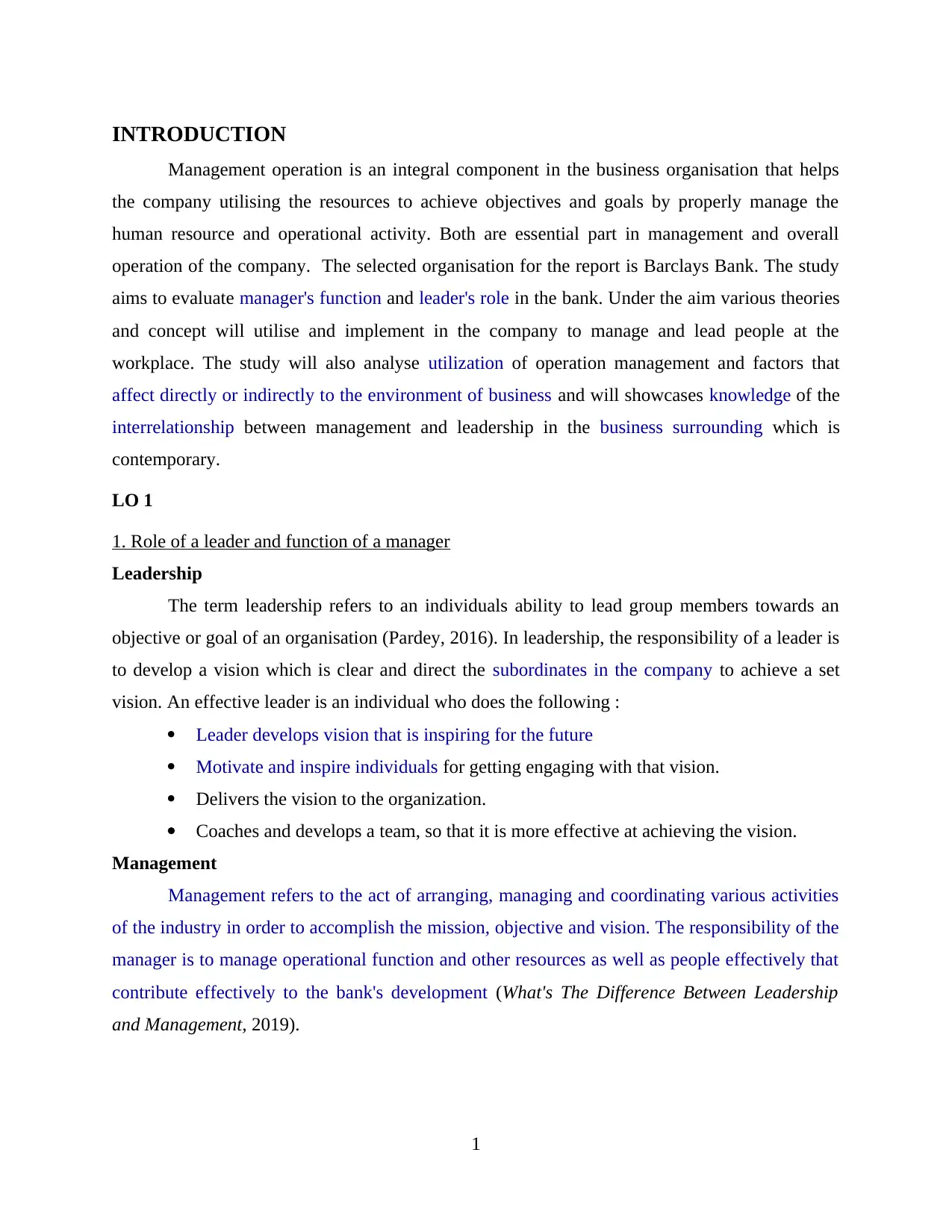
INTRODUCTION
Management operation is an integral component in the business organisation that helps
the company utilising the resources to achieve objectives and goals by properly manage the
human resource and operational activity. Both are essential part in management and overall
operation of the company. The selected organisation for the report is Barclays Bank. The study
aims to evaluate manager's function and leader's role in the bank. Under the aim various theories
and concept will utilise and implement in the company to manage and lead people at the
workplace. The study will also analyse utilization of operation management and factors that
affect directly or indirectly to the environment of business and will showcases knowledge of the
interrelationship between management and leadership in the business surrounding which is
contemporary.
LO 1
1. Role of a leader and function of a manager
Leadership
The term leadership refers to an individuals ability to lead group members towards an
objective or goal of an organisation (Pardey, 2016). In leadership, the responsibility of a leader is
to develop a vision which is clear and direct the subordinates in the company to achieve a set
vision. An effective leader is an individual who does the following :
Leader develops vision that is inspiring for the future
Motivate and inspire individuals for getting engaging with that vision.
Delivers the vision to the organization.
Coaches and develops a team, so that it is more effective at achieving the vision.
Management
Management refers to the act of arranging, managing and coordinating various activities
of the industry in order to accomplish the mission, objective and vision. The responsibility of the
manager is to manage operational function and other resources as well as people effectively that
contribute effectively to the bank's development (What's The Difference Between Leadership
and Management, 2019).
1
Management operation is an integral component in the business organisation that helps
the company utilising the resources to achieve objectives and goals by properly manage the
human resource and operational activity. Both are essential part in management and overall
operation of the company. The selected organisation for the report is Barclays Bank. The study
aims to evaluate manager's function and leader's role in the bank. Under the aim various theories
and concept will utilise and implement in the company to manage and lead people at the
workplace. The study will also analyse utilization of operation management and factors that
affect directly or indirectly to the environment of business and will showcases knowledge of the
interrelationship between management and leadership in the business surrounding which is
contemporary.
LO 1
1. Role of a leader and function of a manager
Leadership
The term leadership refers to an individuals ability to lead group members towards an
objective or goal of an organisation (Pardey, 2016). In leadership, the responsibility of a leader is
to develop a vision which is clear and direct the subordinates in the company to achieve a set
vision. An effective leader is an individual who does the following :
Leader develops vision that is inspiring for the future
Motivate and inspire individuals for getting engaging with that vision.
Delivers the vision to the organization.
Coaches and develops a team, so that it is more effective at achieving the vision.
Management
Management refers to the act of arranging, managing and coordinating various activities
of the industry in order to accomplish the mission, objective and vision. The responsibility of the
manager is to manage operational function and other resources as well as people effectively that
contribute effectively to the bank's development (What's The Difference Between Leadership
and Management, 2019).
1
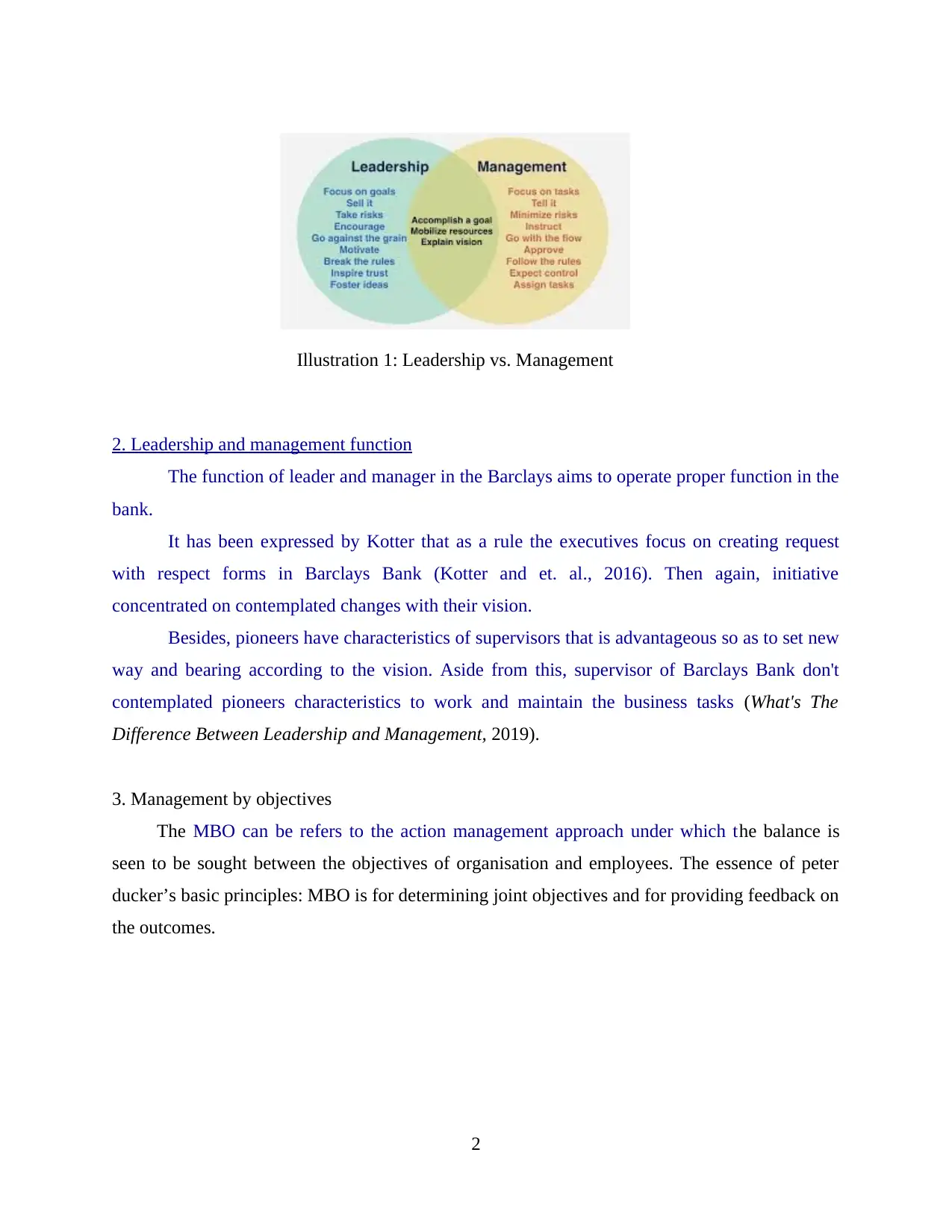
2. Leadership and management function
The function of leader and manager in the Barclays aims to operate proper function in the
bank.
It has been expressed by Kotter that as a rule the executives focus on creating request
with respect forms in Barclays Bank (Kotter and et. al., 2016). Then again, initiative
concentrated on contemplated changes with their vision.
Besides, pioneers have characteristics of supervisors that is advantageous so as to set new
way and bearing according to the vision. Aside from this, supervisor of Barclays Bank don't
contemplated pioneers characteristics to work and maintain the business tasks (What's The
Difference Between Leadership and Management, 2019).
3. Management by objectives
The MBO can be refers to the action management approach under which the balance is
seen to be sought between the objectives of organisation and employees. The essence of peter
ducker’s basic principles: MBO is for determining joint objectives and for providing feedback on
the outcomes.
2
Illustration 1: Leadership vs. Management
The function of leader and manager in the Barclays aims to operate proper function in the
bank.
It has been expressed by Kotter that as a rule the executives focus on creating request
with respect forms in Barclays Bank (Kotter and et. al., 2016). Then again, initiative
concentrated on contemplated changes with their vision.
Besides, pioneers have characteristics of supervisors that is advantageous so as to set new
way and bearing according to the vision. Aside from this, supervisor of Barclays Bank don't
contemplated pioneers characteristics to work and maintain the business tasks (What's The
Difference Between Leadership and Management, 2019).
3. Management by objectives
The MBO can be refers to the action management approach under which the balance is
seen to be sought between the objectives of organisation and employees. The essence of peter
ducker’s basic principles: MBO is for determining joint objectives and for providing feedback on
the outcomes.
2
Illustration 1: Leadership vs. Management
⊘ This is a preview!⊘
Do you want full access?
Subscribe today to unlock all pages.

Trusted by 1+ million students worldwide
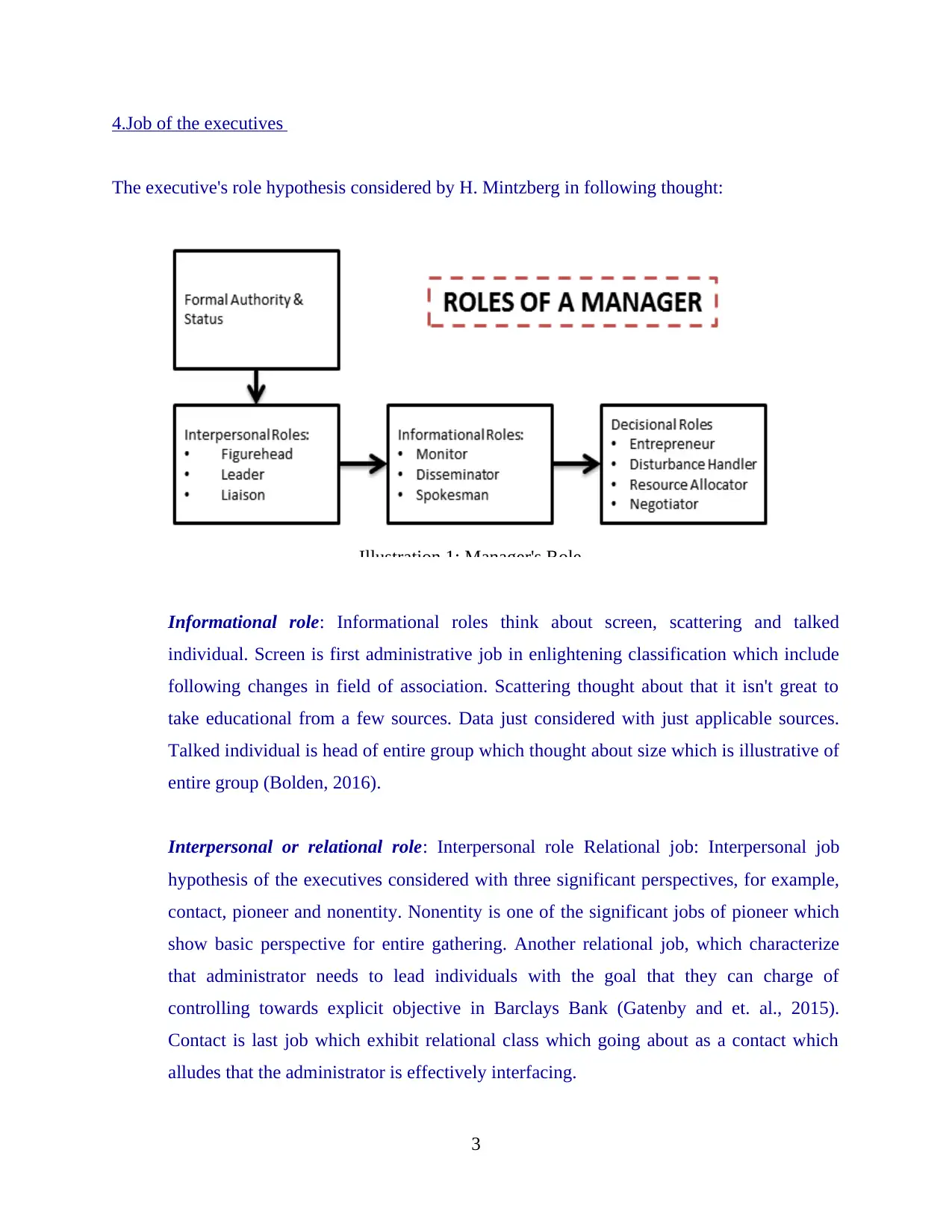
4.Job of the executives
The executive's role hypothesis considered by H. Mintzberg in following thought:
Informational role: Informational roles think about screen, scattering and talked
individual. Screen is first administrative job in enlightening classification which include
following changes in field of association. Scattering thought about that it isn't great to
take educational from a few sources. Data just considered with just applicable sources.
Talked individual is head of entire group which thought about size which is illustrative of
entire group (Bolden, 2016).
Interpersonal or relational role: Interpersonal role Relational job: Interpersonal job
hypothesis of the executives considered with three significant perspectives, for example,
contact, pioneer and nonentity. Nonentity is one of the significant jobs of pioneer which
show basic perspective for entire gathering. Another relational job, which characterize
that administrator needs to lead individuals with the goal that they can charge of
controlling towards explicit objective in Barclays Bank (Gatenby and et. al., 2015).
Contact is last job which exhibit relational class which going about as a contact which
alludes that the administrator is effectively interfacing.
3
Illustration 1: Manager's Role
The executive's role hypothesis considered by H. Mintzberg in following thought:
Informational role: Informational roles think about screen, scattering and talked
individual. Screen is first administrative job in enlightening classification which include
following changes in field of association. Scattering thought about that it isn't great to
take educational from a few sources. Data just considered with just applicable sources.
Talked individual is head of entire group which thought about size which is illustrative of
entire group (Bolden, 2016).
Interpersonal or relational role: Interpersonal role Relational job: Interpersonal job
hypothesis of the executives considered with three significant perspectives, for example,
contact, pioneer and nonentity. Nonentity is one of the significant jobs of pioneer which
show basic perspective for entire gathering. Another relational job, which characterize
that administrator needs to lead individuals with the goal that they can charge of
controlling towards explicit objective in Barclays Bank (Gatenby and et. al., 2015).
Contact is last job which exhibit relational class which going about as a contact which
alludes that the administrator is effectively interfacing.
3
Illustration 1: Manager's Role
Paraphrase This Document
Need a fresh take? Get an instant paraphrase of this document with our AI Paraphraser
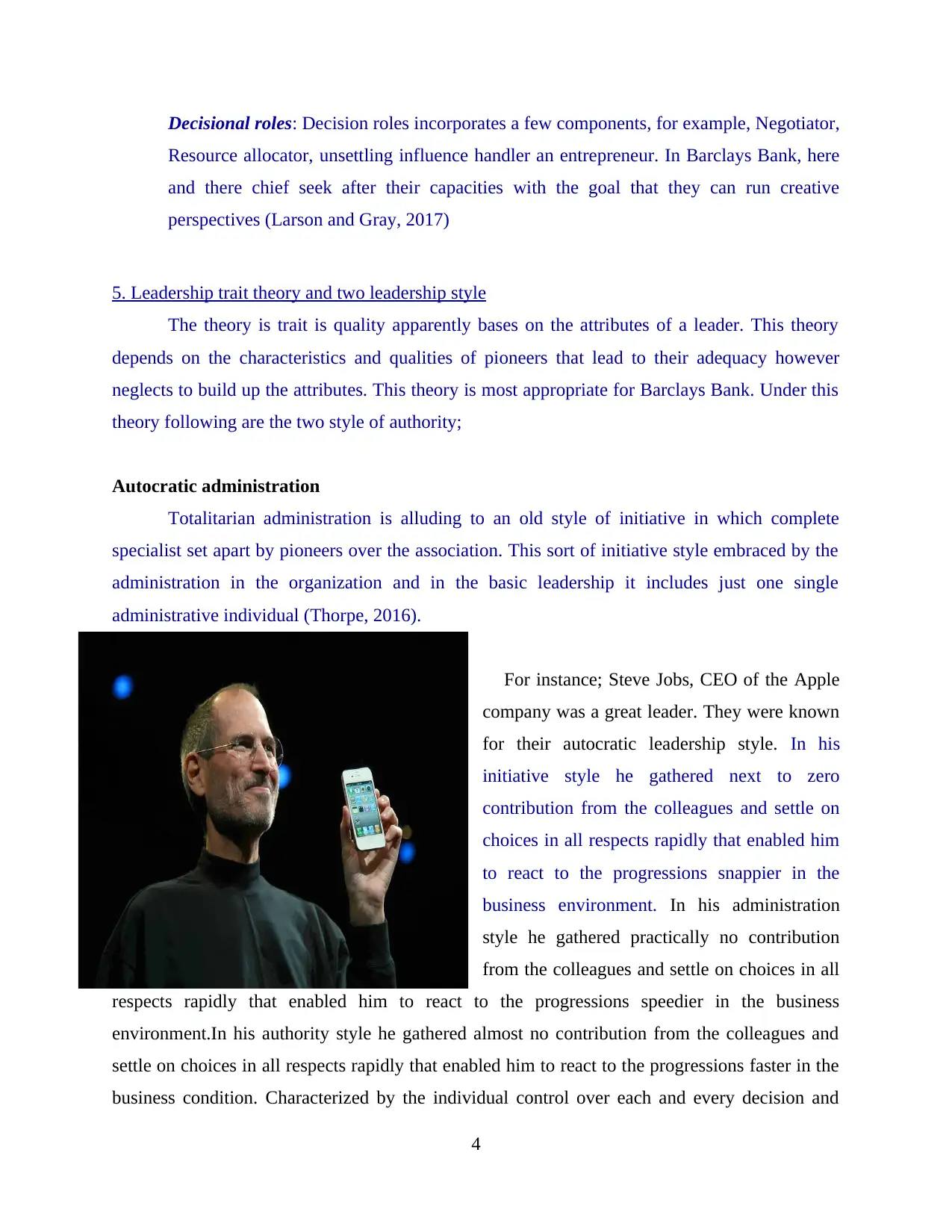
Decisional roles: Decision roles incorporates a few components, for example, Negotiator,
Resource allocator, unsettling influence handler an entrepreneur. In Barclays Bank, here
and there chief seek after their capacities with the goal that they can run creative
perspectives (Larson and Gray, 2017)
5. Leadership trait theory and two leadership style
The theory is trait is quality apparently bases on the attributes of a leader. This theory
depends on the characteristics and qualities of pioneers that lead to their adequacy however
neglects to build up the attributes. This theory is most appropriate for Barclays Bank. Under this
theory following are the two style of authority;
Autocratic administration
Totalitarian administration is alluding to an old style of initiative in which complete
specialist set apart by pioneers over the association. This sort of initiative style embraced by the
administration in the organization and in the basic leadership it includes just one single
administrative individual (Thorpe, 2016).
For instance; Steve Jobs, CEO of the Apple
company was a great leader. They were known
for their autocratic leadership style. In his
initiative style he gathered next to zero
contribution from the colleagues and settle on
choices in all respects rapidly that enabled him
to react to the progressions snappier in the
business environment. In his administration
style he gathered practically no contribution
from the colleagues and settle on choices in all
respects rapidly that enabled him to react to the progressions speedier in the business
environment.In his authority style he gathered almost no contribution from the colleagues and
settle on choices in all respects rapidly that enabled him to react to the progressions faster in the
business condition. Characterized by the individual control over each and every decision and
4
Resource allocator, unsettling influence handler an entrepreneur. In Barclays Bank, here
and there chief seek after their capacities with the goal that they can run creative
perspectives (Larson and Gray, 2017)
5. Leadership trait theory and two leadership style
The theory is trait is quality apparently bases on the attributes of a leader. This theory
depends on the characteristics and qualities of pioneers that lead to their adequacy however
neglects to build up the attributes. This theory is most appropriate for Barclays Bank. Under this
theory following are the two style of authority;
Autocratic administration
Totalitarian administration is alluding to an old style of initiative in which complete
specialist set apart by pioneers over the association. This sort of initiative style embraced by the
administration in the organization and in the basic leadership it includes just one single
administrative individual (Thorpe, 2016).
For instance; Steve Jobs, CEO of the Apple
company was a great leader. They were known
for their autocratic leadership style. In his
initiative style he gathered next to zero
contribution from the colleagues and settle on
choices in all respects rapidly that enabled him
to react to the progressions snappier in the
business environment. In his administration
style he gathered practically no contribution
from the colleagues and settle on choices in all
respects rapidly that enabled him to react to the progressions speedier in the business
environment.In his authority style he gathered almost no contribution from the colleagues and
settle on choices in all respects rapidly that enabled him to react to the progressions faster in the
business condition. Characterized by the individual control over each and every decision and
4
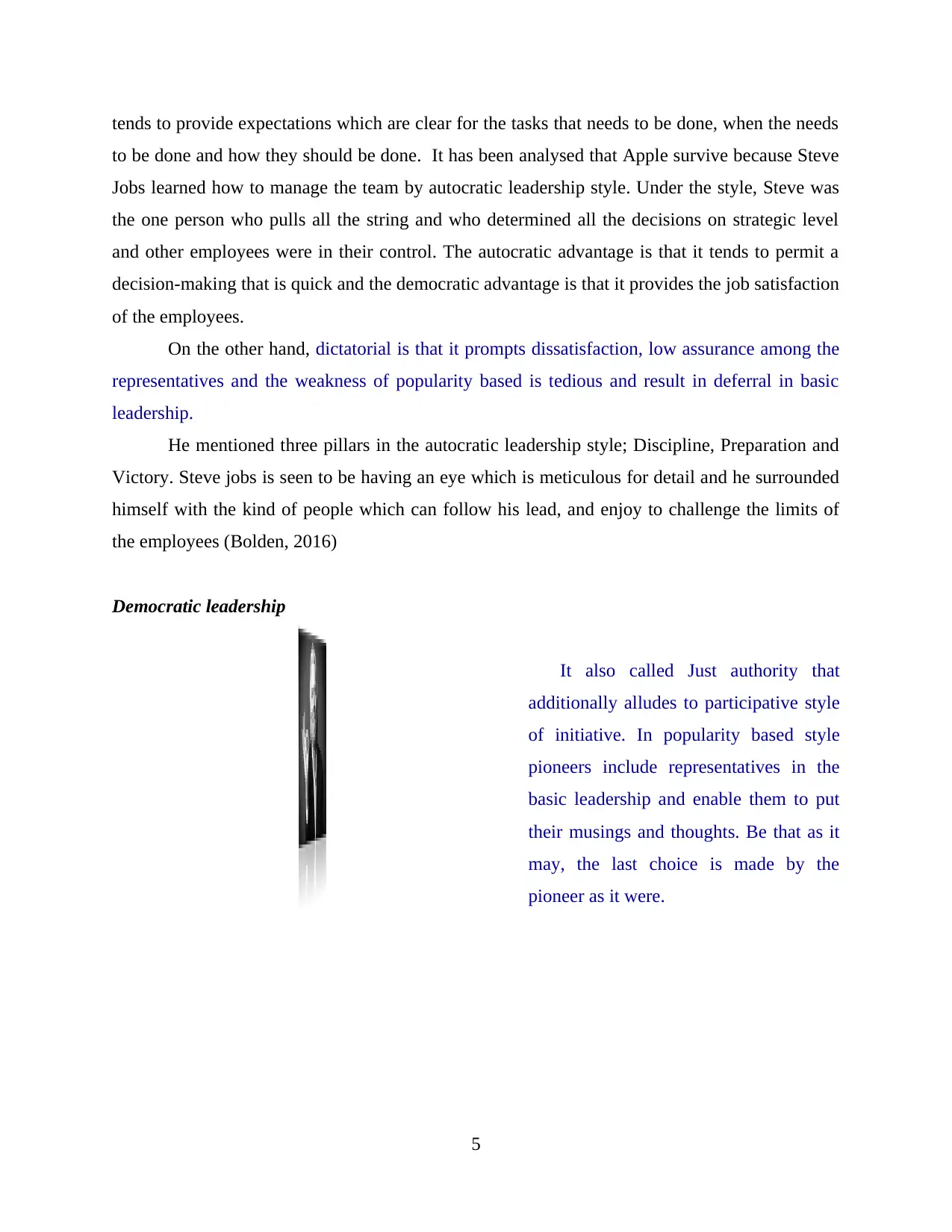
tends to provide expectations which are clear for the tasks that needs to be done, when the needs
to be done and how they should be done. It has been analysed that Apple survive because Steve
Jobs learned how to manage the team by autocratic leadership style. Under the style, Steve was
the one person who pulls all the string and who determined all the decisions on strategic level
and other employees were in their control. The autocratic advantage is that it tends to permit a
decision-making that is quick and the democratic advantage is that it provides the job satisfaction
of the employees.
On the other hand, dictatorial is that it prompts dissatisfaction, low assurance among the
representatives and the weakness of popularity based is tedious and result in deferral in basic
leadership.
He mentioned three pillars in the autocratic leadership style; Discipline, Preparation and
Victory. Steve jobs is seen to be having an eye which is meticulous for detail and he surrounded
himself with the kind of people which can follow his lead, and enjoy to challenge the limits of
the employees (Bolden, 2016)
Democratic leadership
It also called Just authority that
additionally alludes to participative style
of initiative. In popularity based style
pioneers include representatives in the
basic leadership and enable them to put
their musings and thoughts. Be that as it
may, the last choice is made by the
pioneer as it were.
5
to be done and how they should be done. It has been analysed that Apple survive because Steve
Jobs learned how to manage the team by autocratic leadership style. Under the style, Steve was
the one person who pulls all the string and who determined all the decisions on strategic level
and other employees were in their control. The autocratic advantage is that it tends to permit a
decision-making that is quick and the democratic advantage is that it provides the job satisfaction
of the employees.
On the other hand, dictatorial is that it prompts dissatisfaction, low assurance among the
representatives and the weakness of popularity based is tedious and result in deferral in basic
leadership.
He mentioned three pillars in the autocratic leadership style; Discipline, Preparation and
Victory. Steve jobs is seen to be having an eye which is meticulous for detail and he surrounded
himself with the kind of people which can follow his lead, and enjoy to challenge the limits of
the employees (Bolden, 2016)
Democratic leadership
It also called Just authority that
additionally alludes to participative style
of initiative. In popularity based style
pioneers include representatives in the
basic leadership and enable them to put
their musings and thoughts. Be that as it
may, the last choice is made by the
pioneer as it were.
5
⊘ This is a preview!⊘
Do you want full access?
Subscribe today to unlock all pages.

Trusted by 1+ million students worldwide
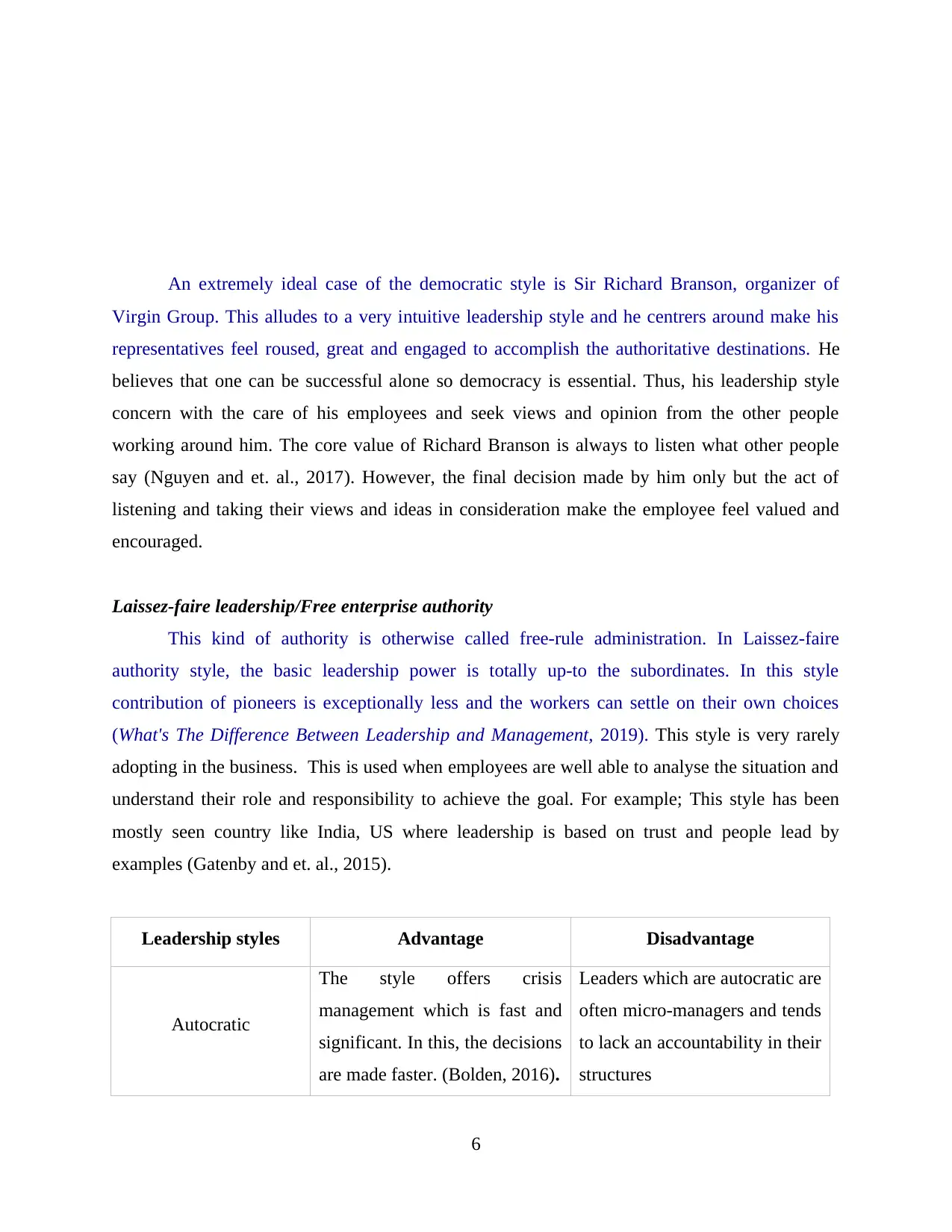
An extremely ideal case of the democratic style is Sir Richard Branson, organizer of
Virgin Group. This alludes to a very intuitive leadership style and he centrers around make his
representatives feel roused, great and engaged to accomplish the authoritative destinations. He
believes that one can be successful alone so democracy is essential. Thus, his leadership style
concern with the care of his employees and seek views and opinion from the other people
working around him. The core value of Richard Branson is always to listen what other people
say (Nguyen and et. al., 2017). However, the final decision made by him only but the act of
listening and taking their views and ideas in consideration make the employee feel valued and
encouraged.
Laissez-faire leadership/Free enterprise authority
This kind of authority is otherwise called free-rule administration. In Laissez-faire
authority style, the basic leadership power is totally up-to the subordinates. In this style
contribution of pioneers is exceptionally less and the workers can settle on their own choices
(What's The Difference Between Leadership and Management, 2019). This style is very rarely
adopting in the business. This is used when employees are well able to analyse the situation and
understand their role and responsibility to achieve the goal. For example; This style has been
mostly seen country like India, US where leadership is based on trust and people lead by
examples (Gatenby and et. al., 2015).
Leadership styles Advantage Disadvantage
Autocratic
The style offers crisis
management which is fast and
significant. In this, the decisions
are made faster. (Bolden, 2016).
Leaders which are autocratic are
often micro-managers and tends
to lack an accountability in their
structures
6
Virgin Group. This alludes to a very intuitive leadership style and he centrers around make his
representatives feel roused, great and engaged to accomplish the authoritative destinations. He
believes that one can be successful alone so democracy is essential. Thus, his leadership style
concern with the care of his employees and seek views and opinion from the other people
working around him. The core value of Richard Branson is always to listen what other people
say (Nguyen and et. al., 2017). However, the final decision made by him only but the act of
listening and taking their views and ideas in consideration make the employee feel valued and
encouraged.
Laissez-faire leadership/Free enterprise authority
This kind of authority is otherwise called free-rule administration. In Laissez-faire
authority style, the basic leadership power is totally up-to the subordinates. In this style
contribution of pioneers is exceptionally less and the workers can settle on their own choices
(What's The Difference Between Leadership and Management, 2019). This style is very rarely
adopting in the business. This is used when employees are well able to analyse the situation and
understand their role and responsibility to achieve the goal. For example; This style has been
mostly seen country like India, US where leadership is based on trust and people lead by
examples (Gatenby and et. al., 2015).
Leadership styles Advantage Disadvantage
Autocratic
The style offers crisis
management which is fast and
significant. In this, the decisions
are made faster. (Bolden, 2016).
Leaders which are autocratic are
often micro-managers and tends
to lack an accountability in their
structures
6
Paraphrase This Document
Need a fresh take? Get an instant paraphrase of this document with our AI Paraphraser
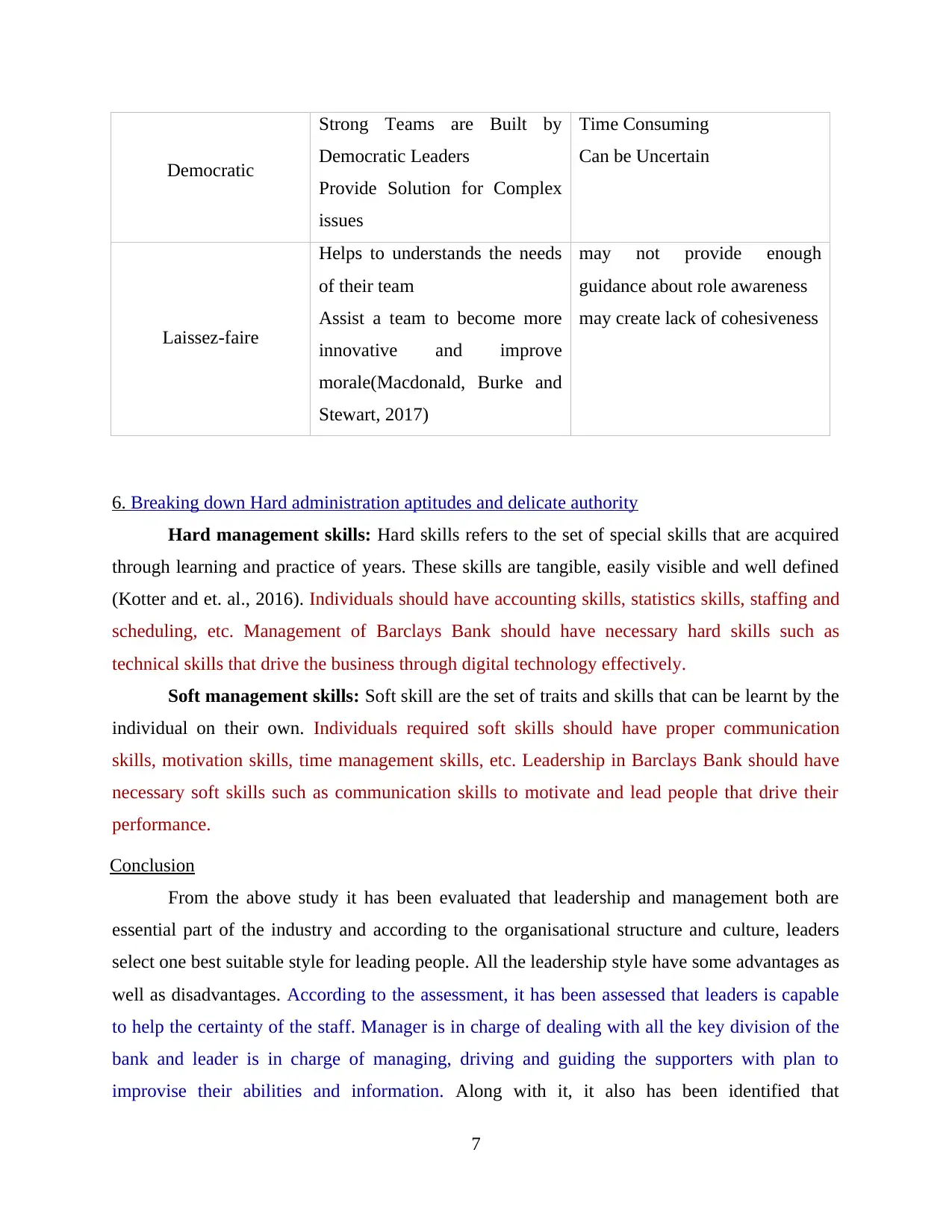
Democratic
Strong Teams are Built by
Democratic Leaders
Provide Solution for Complex
issues
Time Consuming
Can be Uncertain
Laissez-faire
Helps to understands the needs
of their team
Assist a team to become more
innovative and improve
morale(Macdonald, Burke and
Stewart, 2017)
may not provide enough
guidance about role awareness
may create lack of cohesiveness
6. Breaking down Hard administration aptitudes and delicate authority
Hard management skills: Hard skills refers to the set of special skills that are acquired
through learning and practice of years. These skills are tangible, easily visible and well defined
(Kotter and et. al., 2016). Individuals should have accounting skills, statistics skills, staffing and
scheduling, etc. Management of Barclays Bank should have necessary hard skills such as
technical skills that drive the business through digital technology effectively.
Soft management skills: Soft skill are the set of traits and skills that can be learnt by the
individual on their own. Individuals required soft skills should have proper communication
skills, motivation skills, time management skills, etc. Leadership in Barclays Bank should have
necessary soft skills such as communication skills to motivate and lead people that drive their
performance.
Conclusion
From the above study it has been evaluated that leadership and management both are
essential part of the industry and according to the organisational structure and culture, leaders
select one best suitable style for leading people. All the leadership style have some advantages as
well as disadvantages. According to the assessment, it has been assessed that leaders is capable
to help the certainty of the staff. Manager is in charge of dealing with all the key division of the
bank and leader is in charge of managing, driving and guiding the supporters with plan to
improvise their abilities and information. Along with it, it also has been identified that
7
Strong Teams are Built by
Democratic Leaders
Provide Solution for Complex
issues
Time Consuming
Can be Uncertain
Laissez-faire
Helps to understands the needs
of their team
Assist a team to become more
innovative and improve
morale(Macdonald, Burke and
Stewart, 2017)
may not provide enough
guidance about role awareness
may create lack of cohesiveness
6. Breaking down Hard administration aptitudes and delicate authority
Hard management skills: Hard skills refers to the set of special skills that are acquired
through learning and practice of years. These skills are tangible, easily visible and well defined
(Kotter and et. al., 2016). Individuals should have accounting skills, statistics skills, staffing and
scheduling, etc. Management of Barclays Bank should have necessary hard skills such as
technical skills that drive the business through digital technology effectively.
Soft management skills: Soft skill are the set of traits and skills that can be learnt by the
individual on their own. Individuals required soft skills should have proper communication
skills, motivation skills, time management skills, etc. Leadership in Barclays Bank should have
necessary soft skills such as communication skills to motivate and lead people that drive their
performance.
Conclusion
From the above study it has been evaluated that leadership and management both are
essential part of the industry and according to the organisational structure and culture, leaders
select one best suitable style for leading people. All the leadership style have some advantages as
well as disadvantages. According to the assessment, it has been assessed that leaders is capable
to help the certainty of the staff. Manager is in charge of dealing with all the key division of the
bank and leader is in charge of managing, driving and guiding the supporters with plan to
improvise their abilities and information. Along with it, it also has been identified that
7
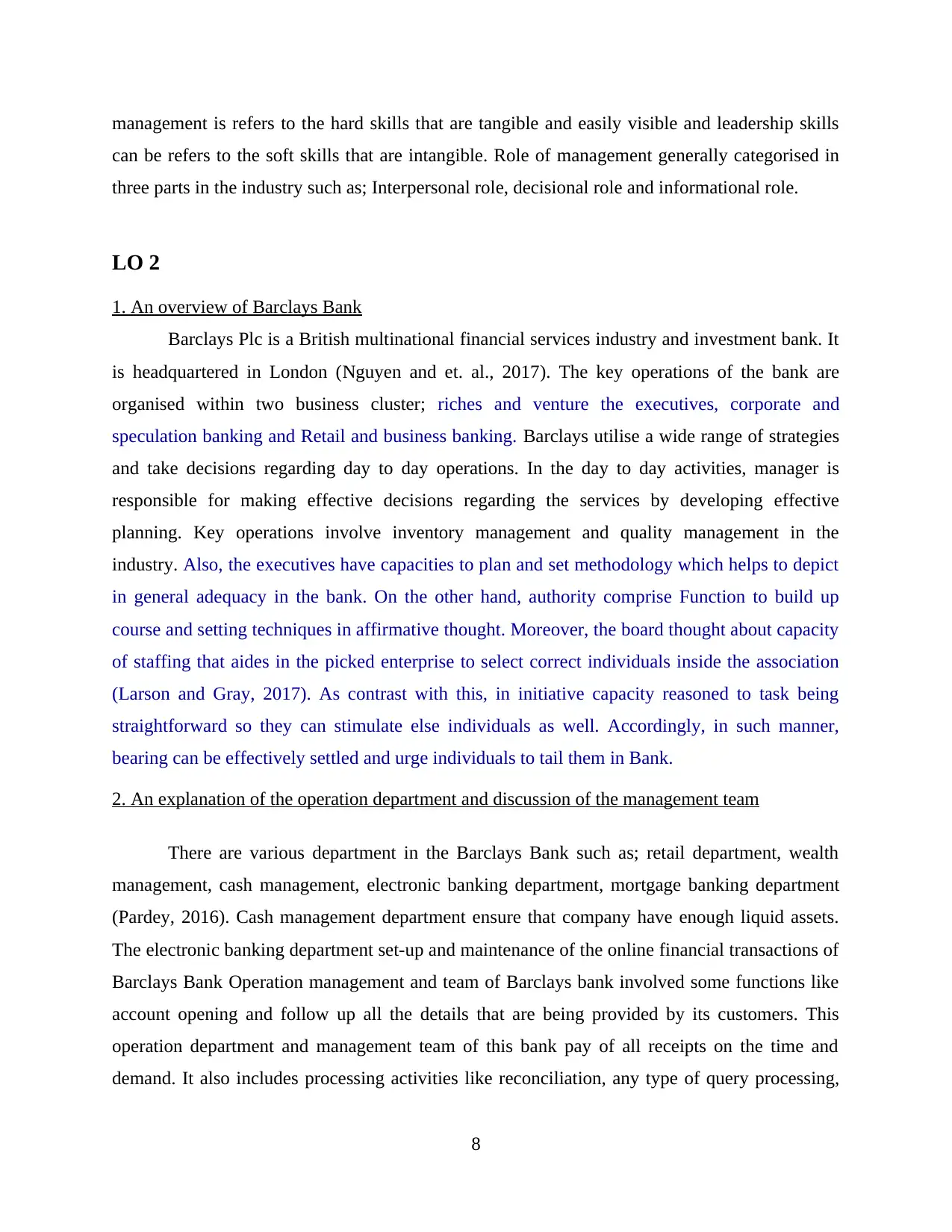
management is refers to the hard skills that are tangible and easily visible and leadership skills
can be refers to the soft skills that are intangible. Role of management generally categorised in
three parts in the industry such as; Interpersonal role, decisional role and informational role.
LO 2
1. An overview of Barclays Bank
Barclays Plc is a British multinational financial services industry and investment bank. It
is headquartered in London (Nguyen and et. al., 2017). The key operations of the bank are
organised within two business cluster; riches and venture the executives, corporate and
speculation banking and Retail and business banking. Barclays utilise a wide range of strategies
and take decisions regarding day to day operations. In the day to day activities, manager is
responsible for making effective decisions regarding the services by developing effective
planning. Key operations involve inventory management and quality management in the
industry. Also, the executives have capacities to plan and set methodology which helps to depict
in general adequacy in the bank. On the other hand, authority comprise Function to build up
course and setting techniques in affirmative thought. Moreover, the board thought about capacity
of staffing that aides in the picked enterprise to select correct individuals inside the association
(Larson and Gray, 2017). As contrast with this, in initiative capacity reasoned to task being
straightforward so they can stimulate else individuals as well. Accordingly, in such manner,
bearing can be effectively settled and urge individuals to tail them in Bank.
2. An explanation of the operation department and discussion of the management team
There are various department in the Barclays Bank such as; retail department, wealth
management, cash management, electronic banking department, mortgage banking department
(Pardey, 2016). Cash management department ensure that company have enough liquid assets.
The electronic banking department set-up and maintenance of the online financial transactions of
Barclays Bank Operation management and team of Barclays bank involved some functions like
account opening and follow up all the details that are being provided by its customers. This
operation department and management team of this bank pay of all receipts on the time and
demand. It also includes processing activities like reconciliation, any type of query processing,
8
can be refers to the soft skills that are intangible. Role of management generally categorised in
three parts in the industry such as; Interpersonal role, decisional role and informational role.
LO 2
1. An overview of Barclays Bank
Barclays Plc is a British multinational financial services industry and investment bank. It
is headquartered in London (Nguyen and et. al., 2017). The key operations of the bank are
organised within two business cluster; riches and venture the executives, corporate and
speculation banking and Retail and business banking. Barclays utilise a wide range of strategies
and take decisions regarding day to day operations. In the day to day activities, manager is
responsible for making effective decisions regarding the services by developing effective
planning. Key operations involve inventory management and quality management in the
industry. Also, the executives have capacities to plan and set methodology which helps to depict
in general adequacy in the bank. On the other hand, authority comprise Function to build up
course and setting techniques in affirmative thought. Moreover, the board thought about capacity
of staffing that aides in the picked enterprise to select correct individuals inside the association
(Larson and Gray, 2017). As contrast with this, in initiative capacity reasoned to task being
straightforward so they can stimulate else individuals as well. Accordingly, in such manner,
bearing can be effectively settled and urge individuals to tail them in Bank.
2. An explanation of the operation department and discussion of the management team
There are various department in the Barclays Bank such as; retail department, wealth
management, cash management, electronic banking department, mortgage banking department
(Pardey, 2016). Cash management department ensure that company have enough liquid assets.
The electronic banking department set-up and maintenance of the online financial transactions of
Barclays Bank Operation management and team of Barclays bank involved some functions like
account opening and follow up all the details that are being provided by its customers. This
operation department and management team of this bank pay of all receipts on the time and
demand. It also includes processing activities like reconciliation, any type of query processing,
8
⊘ This is a preview!⊘
Do you want full access?
Subscribe today to unlock all pages.

Trusted by 1+ million students worldwide
1 out of 23
Related Documents
Your All-in-One AI-Powered Toolkit for Academic Success.
+13062052269
info@desklib.com
Available 24*7 on WhatsApp / Email
![[object Object]](/_next/static/media/star-bottom.7253800d.svg)
Unlock your academic potential
Copyright © 2020–2025 A2Z Services. All Rights Reserved. Developed and managed by ZUCOL.





